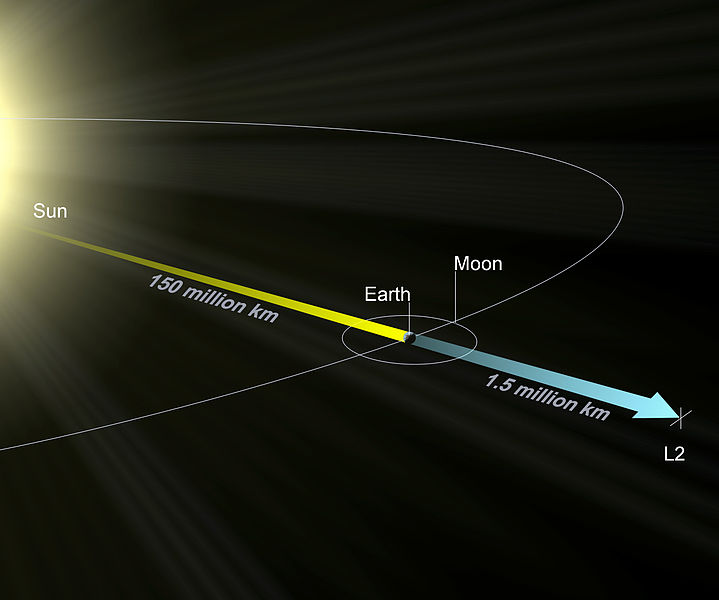On 19 December at 9:12 UT, a Soyuz rocket with a Fregat upper stage carrying ESA's 2-tonne astrometric space telescope Gaia lifted off from Kourou in French Guiana. It's destination: the L2 Lagrange point of the Sun and Earth, some 1.5 million kilometer from the latter.
Gaia artist impression (ESA)
(wikicommons)
ESA, the Dutch Research School for Astronomy NOVA, the Netherlands Space Office NSO and TNO organised a launch event at Noordwijk SpaceExpo on the morning of the launch, and Marieke Baan of NOVA was so kind to invite me for this event. As part of the event we all watched the launch Live on a big screen, with live narration by Juan de Dalmau, and next awaited confirmation of the separation of Gaia from the Fregat upper stage and the crucial last bottleneck, the deployment of Gaia's folded sun shield.
At the launch the audience was 'as silent as a mouse' as we say in Dutch. Applause was there following successful separation from the Fregat stage, and again upon confirmation of the solar shield deployment. The short video below shows the first two of these three moments:
The audience largely consisted of people from the Space Industry and journalists, and apart from watching the launch live on the big screen, they were treated on small lectures by a few of the people involved in the project. Marieke Baan (NOVA) acted as a moderator of the talks.
After an introduction by Juan de Dalmau we first watched the launch broadcast. This was followed by a very fine lecture by ESA astronomer Rene Laureijs, who detailed what work Gaia will do and what techniques it will employ. Next, Leiden astronomer Simon Portegies Zwart told us what 'revolution' Gaia will bring to astronomy. This was followed by a technical talk about the development of the equipment by TNO's Wim Gielesen.
Renee Laureijs (ESA) lecturing
Over the next five years, this telescope will record positions, distance and proper motion characteristics of one billion stars, creating a detailed 3D map (or 4D, given that movement in time is involved...) of our galaxy. It will do so 50 to 100 times more accurate than previous efforts, and for about 10 000 times as much stars.
In the course of this work, the satellite is expected to also record positional data on some 300 000 asteroids in our solar system, detect the tell-tale signs of exoplanets with other stars, as well as record Quasars and transient phenomena such as supernovae in other galaxies, not to speak of providing more insights into stellar evolution. It is also expected to measure the bending of starlight by the sun's gravitational field and in this way test Einstein's General Theory of Relativity.
The only thing it does not seem to do is brew a decent cup of coffee...
The sensor of the satellite is equivalent to a 1000 megapixel CCD. For about 1 billion stars, Gaia will determine on average 70 positions per object (and in some selected cases more), measured over a 5 year operational period. It will measure their positions, do photometry and determine the object's radial speed. It does so by means of parallax measurements with an accuracy of 0.026 milli arcseconds (!). To give you an idea of this accuracy: it means the positions are pinpointed with no more leeway than the diameter of a Euro coin at the distance of the moon.
Starting in May 2014, the satellite will produce 40 Gb of data per day, for five years. In other words: an incredible amount of data.
A Dutch-Italian girl named Gaia was a special guest
The Netherlands plays an important role in this mission. Part of the initial data processing will be done here. Much of the spacecraft's frame and optical assembly were developed and built by TNO, while Dutchspace built a crucial Real-Time Simulator (RTS).





No comments:
Post a Comment